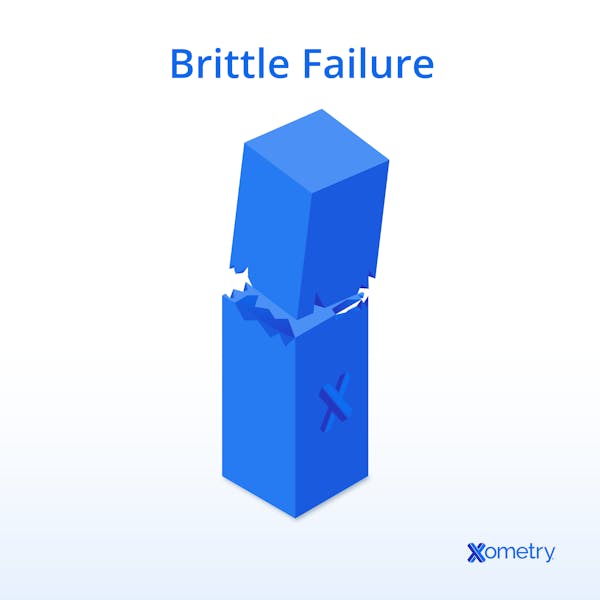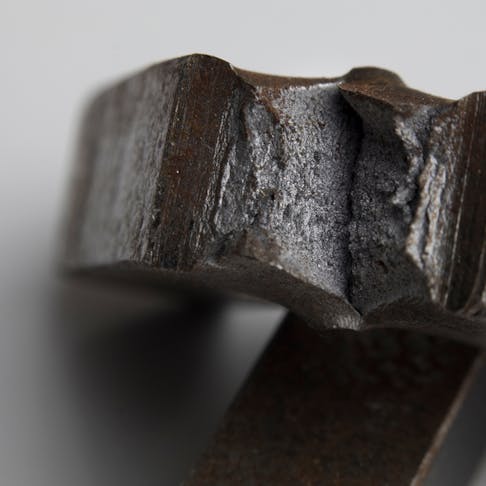Brittleness is a material property that describes its tendency to fracture with little to no plastic deformation when stress is applied to it. Brittle behavior results when atoms in a material cannot slip past each other while maintaining the overall integrity of the atomic lattice structure. Cracks in brittle materials form and propagate rapidly either across grains or along grain boundaries when they are subjected to sufficiently high stresses. This process is typically rapid.
Anyone who has ever dropped and broken a dinner plate or a pencil tip is familiar with brittle materials. Examples of brittle materials include glass, ceramics, graphite, and alloys with low ductility, such as steels with high carbon content and cast iron.
This article will review the concept of brittleness, explain its causes, and describe examples of brittle materials.
What Is Brittleness?
Brittleness is a material’s tendency to easily break, crack, or snap. Brittleness can occur in metals, ceramics, plastics, glass, and composite materials.
What Is Brittleness in Materials Science?
In materials science, brittleness is the property that characterizes a material’s inclination to fracture with minimal plastic deformation. Brittle materials have a poor capacity to absorb energy before fracturing.
What Is Brittleness in Chemistry?
In chemistry, brittleness refers to a material’s inability to deform due to its atomic microstructure. Some microstructures where atoms have many slip systems and have more opportunity to dislocate make materials less brittle. Others, like those where atoms have few slip systems, result in making materials more brittle.
What Is an Example of Brittleness?
Brittleness can be an innate property or induced by external factors. Materials that are inherently brittle include glass, bricks, eggshells, graphite, and alkali metals like magnesium. Materials that are not inherently brittle but become embrittled due to certain factors, such as cold operating temperatures, intergranular corrosion, and hydrogen embrittlement, include low and high-carbon steels and titanium.

When Does Brittleness of Material Occur?
Brittleness is an intensive physical property of a material, which means it is not affected by the size or extent of the material. While some materials, like most ceramics and glasses, are inherently brittle due to their atomic structures and lack of available slip systems, some normally ductile materials can become brittle as temperatures decrease.
Normally, ductile materials can also be embrittled by hydrogen or corrosion along grain boundaries. Hydrogen embrittlement occurs via a variety of complex mechanisms which are still not completely understood. The common feature is that atoms of hydrogen (not molecules of H2 gas) diffuse into the metal and wreak havoc. The deleterious effects can be caused by the formation of gaseous species that raise internal pressure, the formation of brittle solid-state compounds, or by enhancing the rate of dislocation movement, which increases the rate of crack propagation in the metal.
Intergranular corrosion occurs when a metal is preferentially attacked by a corrosive agent at what can be weak points on its surface: boundaries between grains. Intergranular corrosion typically results in the deposition of brittle corrosion products between grains, replacing the normally ductile metal and providing an easy fracture path through the unwanted brittle material.
What Are the Causes of Brittleness?
The causes of brittleness are not the same for every material. The list below describes some of the common causes in more detail:
- Amorphous materials (like glass) do not have organized atomic structures. There is no easy way for atoms to slip past each other. Dislocations, which are atomic-level defects in crystals, are pinned in place, making amorphous materials brittle.
- Strong ionic bonds between charged atoms resist sliding and make the material brittle. This is often the case with ceramic materials.
- Low temperatures can reduce the thermal energy of atoms within a material and make them more resistant to slip and dislocation.
- Materials with fewer slip systems, or opportunities for dislocation of atoms, are more brittle than materials with more slip systems.
- Impurities, or foreign atoms, in a material can cause brittleness. This is the case with hydrogen embrittlement and for some alloys like cast iron.
What Are the Different Brittle Materials?
Some examples of brittle materials are described below:
1. Glass
Glass is one of the most well-known brittle materials. It is brittle because of its amorphous structure. The atomic-level arrangement of glass lacks the organized structure of crystalline materials. Without organized atomic planes that can slip against each other, the stress tending to pull atoms apart from each other cannot be relieved. It will eventually exceed the strength of the interatomic bonds, resulting in the formation of cracks that rapidly propagate through the material, causing it to break apart suddenly.
2. Ceramics
The term ceramics is applied to a broad range of materials such as cement, enamel, brick, porcelain, and pottery. For crystallized ceramics, atomic structures are primarily composed of strong ionic bonds between charged atoms. These ionic bonds form crystals which make it more difficult for the atomic planes to slip against each other. Consequently, it is difficult for atoms to dislocate which makes the material brittle.
3. Graphite
Graphite is a soft and brittle crystalline form of carbon with a hexagonal close-packed (HCP) crystal structure. Brittleness can be attributed to the crystal structure of a particular material and the number of slip systems the structure has. Materials with crystal structures that have fewer slip systems are more brittle because their atoms are more resistant to dislocating. HCP structures in graphite have three slip systems, while face-centered cubic (FCC) systems in another carbon allotrope, diamond, have 12 slip systems. Additionally, graphite has strong covalent bonds between atoms within the same plane, but weak bonds between planes. Both this and its HCP structure contribute to graphite being brittle.
4. Alloys With Low Plasticity
Alloys with low plasticity, such as cast iron and titanium, are also examples of brittle materials. The crystal structure has a large impact on the brittleness of an alloy. For example, materials that have an FCC structure such as copper are more ductile than materials that have an HCP structure such as titanium or magnesium. FCC structures have 12 slip systems while HCP structures only have 3 slip systems. Having 3 slip systems makes HCP structures more brittle because the atoms within its structure are more resistant to dislocating.
What Is the Importance of Identifying Brittleness?
It is important to identify brittle materials because of the implications brittle materials may have on the successful implementation and durability of a design. Brittle materials are often selected for designs because of their high strength. However, because brittle materials can fracture with little to no warning, brittle failure can be catastrophic. It is recommended to select more ductile materials that can sustain the loads required by the brittle material in designs.
How Is Brittleness Determined?
Brittleness is determined by completing a tensile test and calculating the ductility of a material. A material is considered to be brittle if it exhibits low ductility during a tensile test. The standard test method for conducting tensile tests on metallic materials is ASTM E8. The corresponding procedure for plastics can be found in ASTM D638. A tensile test consists of preparing a test specimen to standardized dimensions and then applying a constantly increasing tensile load until the specimen breaks. The values for the stress and strain experienced by the specimen are recorded and used to determine ductility and, indirectly, its brittleness.
What Is the Formula for Brittleness?
There is no formula specifically for brittleness. However, the brittleness of a material can be deduced from one of the two ductility formulas shown below:
Ductility is defined as the percentage of total elongation experienced by material from the beginning of the test until fracture, or the corresponding percentage reduction of the cross-sectional area experienced by a material at fracture.
The lower the measured ductility, the more brittle a material is considered to be. The percentage elongation formula is the same as the formula for engineering strain.
See our article “How To Calculate Ductility?” for a more detailed overview of the topic of ductility.
What Are the Types of Brittleness?
The two types of brittle fractures are transgranular and intergranular. They are described in more detail below:
- Transgranular: Cracks propagate across the grains of the material. Cracks follow the path of least resistance and will change direction to follow the weakest planes of cleavage. Large grain sizes (fewer grain boundaries) enable cracks to propagate more quickly because grain boundaries impede crack extension. Therefore, large grain sizes contribute to higher levels of brittleness.
- Intergranular: Cracks propagate along the grain boundaries of the material. This is common when the grain boundaries are brittle, which is caused by hydrogen embrittlement and intergranular corrosion.
What Is the Opposite of Brittleness?
Ductility is considered the opposite of brittleness. Ductility is the material property that describes a material’s ability to plastically deform. Understanding the role of fracture mechanics and ductile vs. brittle materials is essential to designing safe, effective, and durable parts and structures.
Is Brittleness a Physical Property?
Yes, brittleness is a physical property. It characterizes how the atoms in the physical structure of the material interact with each other when stress is applied.
What Is the Difference Between “Fragile” and “Brittle?”
“Fragile” and “brittle” are often used synonymously. However, there are differences between their definitions. “Fragile” simply describes a material that is easily broken. While “brittle” also describes materials that are easily broken, it more specifically refers to materials that are hard, rigid and lack significant plastic deformation before breaking. In materials science, "brittle" is more specific in its definition, as it indicates a lack of ductility, meaning the material fractures with minimal deformation. “Fragile” is a broader term and can describe materials that may not be technically brittle but are still easily damaged.
Summary
This article presented brittleness, explained what it is, and discussed the different types of brittle materials. To learn more about brittleness, contact a Xometry representative.
Xometry provides a wide range of manufacturing capabilities, including 3D printing and other value-added services for all of your prototyping and production needs. Visit our website to learn more or to request a free, no-obligation quote.
Disclaimer
The content appearing on this webpage is for informational purposes only. Xometry makes no representation or warranty of any kind, be it expressed or implied, as to the accuracy, completeness, or validity of the information. Any performance parameters, geometric tolerances, specific design features, quality and types of materials, or processes should not be inferred to represent what will be delivered by third-party suppliers or manufacturers through Xometry’s network. Buyers seeking quotes for parts are responsible for defining the specific requirements for those parts. Please refer to our terms and conditions for more information.


